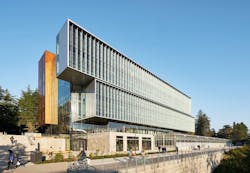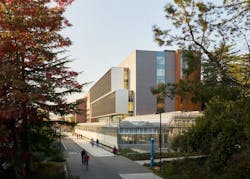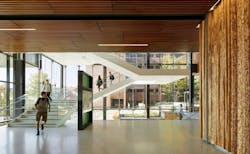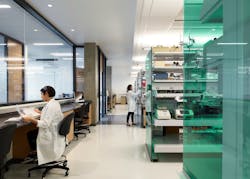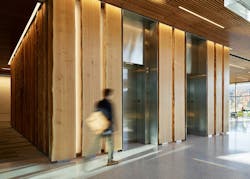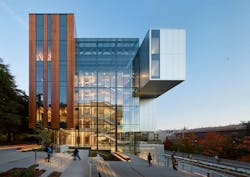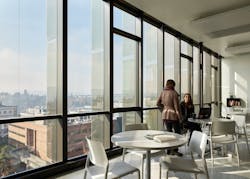New Life Science Building at University of Washington designed for the next generation of research and teaching
The University of Washington Biology department educates more STEM students than any other program in the state, and now it has a new centerpiece in the Perkins+Will-designed Life Science Building (LSB). The 207,000-sf facility features a separate 20,000-sf research and teaching greenhouse with 2,400 species of plants, and will eventually include a direct connection to the LSB.
LSB was designed for team-focused collaboration with offices, laboratories, and common-use spaces in close proximity to each other. The research and teaching areas are open, modular, and flexible to adapt to emerging research questions that require new methods and instruments. A suspended staircase with oversized landing areas further encourages collaboration while a courtyard and rooftop deck provide outdoors space for students and staff. Perhaps LSB’s most unique element is its elevator core that is wrapped in custom-milled slabs from 200-foot Douglas fir trees.
See Also: Suffolk breaks ground on large housing/dining complex for UMass Dartmouth
LSB is tracking to LEED Gold and features sustainability elements such as vertical glass solar fins on its exterior, operable windows for natural ventilation, chilled beams and waves, a water reclamation system for greenhouse irrigation, radiant floors, and rooftop solar panels. The vertical solar glass fins alone are anticipated to generate enough electricity to light more than 12,400 sf of offices throughout the year.
In addition to Perkins+Will, the build team included: Coughlin Porter Lundeen (SE and CE), Affiliated Engineers (mechanical and electrical engineering), Skanska USA (general contractor), McKinstry (mechanical contractor), VECA Electric (electrical contractor), and Gustafson Guthrie Nichol (landscape architect).
